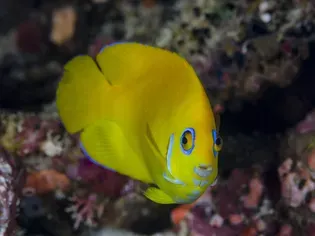Lemonpeel Angelfish: Fish Species Profile
Updated on 04/26/24

Lemonpeel Angelfish: An Astonishing Fish Species Profile Unveiled
Prepare to be captivated as we embark on an extraordinary journey into the world of the Lemonpeel Angelfish, a species renowned for its vibrant hues, graceful demeanor, and captivating presence in the aquarium hobby. This comprehensive profile will delve into every aspect of this mesmerizing fish, providing invaluable insights, practical care tips, and fascinating facts that will ignite your passion for this aquatic gem.
Origin and Natural Habitat
The Lemonpeel Angelfish, scientifically known as Centropyge flavissima, hails from the tropical waters of the Indo-Pacific region, extending from Indonesia to the Solomon Islands. These fish inhabit coral-rich reefs and shallow lagoons, where they seek shelter and sustenance among vibrant corals and diverse marine life. Their natural environment provides an array of food sources, including small invertebrates, algae, and zooplankton.
Physical Characteristics
Lemonpeel Angelfish are adorned with striking coloration that varies depending on their geographic location. Typically, they exhibit a vibrant yellow or lemon-yellow body with an array of electric blue stripes and markings. These bold patterns create a breathtaking contrast, making them a visually captivating addition to any aquarium.
Their compressed, disc-shaped bodies allow them to navigate the narrow crevices and coral formations of their natural habitat with agility and grace. Adults can reach an average size of around 6 inches (15 centimeters), making them a relatively small species of angelfish. Their dorsal, anal, and pelvic fins are adorned with extended filaments, adding an ethereal elegance to their overall appearance.
Behavior and Temperament
Lemonpeel Angelfish are generally peaceful and docile creatures, making them suitable for community aquariums with compatible tankmates. However, they can become territorial when defending their chosen territory, particularly during spawning season. They are known to form monogamous pairs, exhibiting strong bonding and parental care towards their offspring.
In the aquarium, Lemonpeel Angelfish are active and playful, adding a vibrant energy to the tank. They enjoy exploring their surroundings and interacting with other fish species. Their curious and inquisitive nature makes them a delight to observe, providing endless entertainment for aquarium enthusiasts.
Nutrition and Feeding Habits
Lemonpeel Angelfish are omnivorous, with a diverse diet that includes a variety of food sources. In their natural habitat, they feed primarily on small invertebrates, algae, and zooplankton. In the aquarium, they can be offered a balanced diet consisting of high-quality flake food, frozen mysis shrimp, brine shrimp, and algae-based foods.
To ensure optimal health and vitality, it is crucial to provide Lemonpeel Angelfish with a varied and nutritious diet. Regularly offering live or frozen foods will help mimic their natural feeding habits and provide them with essential nutrients.
Breeding and Reproduction
Lemonpeel Angelfish reach sexual maturity at around 12-18 months of age. When ready to spawn, they will form monogamous pairs and select a suitable spawning site within their territory. The female will typically lay a cluster of eggs on a vertical surface, and both parents will take turns guarding and fanning the eggs to ensure proper oxygenation.
The eggs hatch within 3-5 days, and the newly hatched larvae are initially planktonic, drifting freely in the water column. After several weeks, the larvae develop into juvenile fish and begin to take on the coloration and markings of adult Lemonpeel Angelfish.
Aquarium Requirements and Care
Lemonpeel Angelfish require a well-established aquarium with specific parameters to thrive. A minimum tank size of 55 gallons (208 liters) is recommended to provide ample swimming space and reduce aggression. The ideal water temperature range is between 75-82°F (24-28°C), with a pH of 8.1-8.4 and a specific gravity of 1.020-1.025.
The aquarium should be equipped with a reliable filtration system to maintain excellent water quality. Regular water changes of 10-15% weekly are essential to remove waste products and replenish essential minerals. Live rock or other porous decorations provide hiding places and grazing surfaces for Lemonpeel Angelfish.
Compatible Tankmates
Lemonpeel Angelfish can coexist peacefully with a variety of other reef-safe fish species. Suitable tankmates include:
- Clownfish
- Damselfish
- Gobies
- Firefish
- Blennies
- Wrasses (non-aggressive species)
It is important to avoid housing Lemonpeel Angelfish with overly aggressive or predatory species that may pose a threat to their well-being.
Diseases and Health Concerns
Lemonpeel Angelfish are generally hardy and disease-resistant when provided with optimal care. However, like all fish species, they may be susceptible to certain ailments if their environment or health is compromised. Some common diseases to watch out for include:
- Ich or White Spot Disease
- Velvet Disease
- Marine Ich
- Bacterial Infections
Maintaining excellent water quality, providing a nutritious diet, and observing your fish regularly for any signs of distress will help prevent and mitigate health issues. Early detection and prompt treatment are crucial for the well-being of your Lemonpeel Angelfish.
Conclusion
The Lemonpeel Angelfish is a captivating species that brings a vibrant splash of color and grace to any aquarium. Their striking appearance, peaceful nature, and relatively easy care requirements make them a popular choice for both novice and experienced aquarists alike. By understanding their origin, physical characteristics, behavior, and specific needs, you can provide these magnificent fish with the optimal environment to thrive and showcase their breathtaking beauty for years to come.
Explore More Pets

Freshwater Aquarium Filters
How to Deal With Cloudy Aquarium Water

Saltwater Aquarium Filters
How Do You Remove Chloramines From Tap Water?

Freshwater Aquariums & Habitat
Can I Keep My Koi Fish Inside?

Saltwater Aquariums & Habitat
14 Best Floating Plants for Your Aquarium

Freshwater Fish Health
How to Treat Ich on Freshwater Fish

Saltwater Fish Health
Fin Rot in Aquarium Fish

Freshwater Aquarium Filters
How to Do Aquarium Water Changes

Saltwater Fish Health
How Do Fish Get Parasites?